Determination of USV’s Direction Using Satellite and Fluxgate Compasses and GNSS-RTK
Abstract
1. Introduction
2. Materials and Methods
2.1. Measured Parameters and Relationships between Them
2.2. USV and Measurement Sensors
| GNSS | $GPGGA,082319.00,5431.0669492,N,01833.0649214,E,4,08,1.22,−4.0236,M,33.6965,M,2.0,0871*51 $GPGLL,5431.0669492,N,01833.0649214,E,082319.00,A,D*6D $GPGSA,M,3,32,06,19,22,25,17,24,12,,,,,2.23,1.22,1.87*09 $GPGSV,3,1,09,32,27,311,41,06,23,097,40,19,42,060,46,22,14,326,40*71 $GPGSV,3,2,09,25,27,258,39,17,25,047,42,24,68,166,49,12,70,253,48*7A $GPGSV,3,3,09,02,10,139,42*4E $GPVTG,187.581,T,,M,1.2603,N,2.3341,K,D*0B $HCHDM,241.9,M*27 |
| Fluxgate | $GPHDT,138.0153,T*08 |
| Satellite compass | $HCHDM,241.9,M*27 |
3. Results
3.1. Static Measurements—Fluxgate and Satellite Compass
3.2. Linear Trajectory—Long Profiles
3.3. Quick Heading’s Changes on Reciprocal One
3.4. Circulations
4. Discussion
5. Conclusions
Funding
Institutional Review Board Statement
Informed Consent Statement
Data Availability Statement
Conflicts of Interest
References
- Gade, K. The Seven Ways to Find Heading. J. Navig. 2016, 69, 955–970. [Google Scholar] [CrossRef]
- Felski, A. Gyrocompasses—Their Condition and Direction of Development. TransNav Int. J. Mar. Navig. Saf. Sea Transp. 2008, 2, 55–59. [Google Scholar]
- Chichinadze, M.V. Marine Gyrocompasses: Development and Prospects. Gyroscopy Navig. 2018, 9, 358–361. [Google Scholar] [CrossRef]
- Jaskólski, K. Application for Simulating Gyro-Compass Behavior. Annu. Navig. 2016, 23, 159–172. [Google Scholar] [CrossRef]
- Jaskólski, K.; Felski, A.; Piskur, P. The Compass Error Comparison of an Onboard Standard Gyrocompass, Fiber-Optic Gyrocompass (FOG) and Satellite Compass. Sensors 2019, 19, 1942. [Google Scholar] [CrossRef] [PubMed]
- Johnson, B.R.; Cabuz, E.; French, H.B.; Supino, R. Development of a MEMS gyroscope for northfinding applications. In Proceedings of the IEEE/ION Position, Location and Navigation Symposium, Indian Wells, CA, USA, 4–6 May 2010; pp. 168–170. [Google Scholar]
- Emel’yantsev, G.; Stepanov, O.; Stepanov, A.; Blazhnov, B.; Dranitsyna, E.; Evstifeev, M.; Eliseev, D.; Volynskiy, D. Integrated GNSS/IMU-Gyrocompass with Rotating IMU. Development and Test Results. Remote Sens. 2020, 12, 3736. [Google Scholar] [CrossRef]
- Dąbrowski, P.S.; Specht, C.; Felski, A.; Koc, W.; Wilk, A.; Czaplewski, K.; Karwowski, K.; Jaskólski, K.; Specht, M.; Chrostowski, P.; et al. The Accuracy of a Marine Satellite Compass under Terrestrial Urban Conditions. J. Mar. Sci. Eng. 2019, 8, 18. [Google Scholar] [CrossRef]
- Felski, A.; Jaskólski, K.; Zwolak, K.; Piskur, P. Analysis of Satellite Compass Error’s Spectrum. Sensors 2020, 20, 4067. [Google Scholar] [CrossRef]
- Felski, A.; Mięsikowski, M. Some method of determining the characteristic frequencies of ship’s yawing and errors of ship’s compasses during the sea-trials. Annu. Navig. 2000, 2, 17–24. [Google Scholar]
- Felski, A.; Nowak, A. Practical experiences from the use of the satellite compass. In Proceedings of the ENC Conference, Pacific Grove, CA, USA, 29 March–3 April 2009. [Google Scholar]
- Felski, A. Exploitative properties of different types of satellite compasses. Annu. Navig. 2010, 16, 33–40. [Google Scholar]
- Satellite Compass. A Practical Guide to GNSS Transmitting Heading Devices for Marine Navigation. Northrop Grumman. 2005. Available online: https://www.sperrymarine.com/PageResources/767/NavistarGuide.pdf (accessed on 13 April 2020).
- Mięsikowski, M.; Felski, A. Some Aspects of DGPS Based Heading Determination. Geod. Cartogr. 1999, XLVIII, 97–104. [Google Scholar]
- Makar, A.; Specht, C.; Specht, M.; Dąbrowski, P.; Szafran, M. Integrated Geodetic and Hydrographic Measurements of the Yacht Port for Nautical Charts and Dynamic Spatial Presentation. Geosciences 2020, 10, 203. [Google Scholar] [CrossRef]
- Makar, A.; Specht, C.; Specht, M.; Dąbrowski, P.; Burdziakowski, P.; Lewicka, O. Seabed Topography Changes in the Sopot Pier Zone in 2010–2018 Influenced by Tombolo Phenomenon. Sensors 2020, 20, 6061. [Google Scholar] [CrossRef] [PubMed]
- Specht, C.; Makar, A.; Specht, M. Availability of the GNSS Geodetic Networks Position During the Hydrographic Surveys in the Ports. TransNav Int. J. Mar. Navig. Saf. Sea Transp. 2018, 12, 657–661. [Google Scholar] [CrossRef]
- Specht, M.; Specht, C.; Szafran, M.; Makar, A.; Dąbrowski, P.; Lasota, H.; Cywiński, P. The Use of USV to Develop Navigational and Bathymetric Charts of Yacht Ports on the Example of National Sailing Centre in Gdańsk. Remote Sens. 2020, 12, 2585. [Google Scholar] [CrossRef]
- Kurowski, M.; Thal, J.; Damerius, R.; Korte, H.; Jeinsch, T. Automated survey in very shallow water using an unmanned surface vehicle. In Proceedings of the CAMS 2019, 2019, 12th IFAC Conference on Control Applications in Marine Systems, Robotics and Vehicles, Daejeon, Korea, 18–20 September 2019. [Google Scholar]
- Kurowski, M.; Thal, J.; Damerius, R.; Korte, H.; Jeinsch, T. Automated Survey in Very Shallow Water Using an Unmanned Surface Vehicle. IFAC PapersOnLine 2019, 52, 146–151. [Google Scholar] [CrossRef]
- Specht, C.; Świtalski, E.; Specht, M. Application of an Autonomous/Unmanned Survey Vessel (ASV/USV) in Bathymetric Measurements. Pol. Mar. Res. 2017, 24, 36–44. [Google Scholar] [CrossRef]
- Giordano, F.; Mattei, G.; Parente, C.; Peluso, F.; Santamaria, R. Integrating Sensors into a Marine Drone for Bathymetric 3D Surveys in Shallow Waters. Sensors 2016, 16, 41. [Google Scholar] [CrossRef] [PubMed]
- Zhao, J.; Yan, W.; Jin, X. Brief review of autonomous surface crafts. ICIC Expr. Lett. 2011, 5, 4381–4386. [Google Scholar]
- Stanghellini, G.; Del Bianco, F.; Gasperini, L. OpenSWAP, an Open Architecture, Low Cost Class of Autonomous Surface Vehicles for Geophysical Surveys in the Shallow Water Environment. Remote Sens. 2020, 12, 2575. [Google Scholar] [CrossRef]
- Leo, D.; Murali, K.; Chitra, K.; Raju, K. Unmanned Autonomous Surface Vehicle for the Shallow Water Bathymetry Applications. In Proceedings of the OCEANS 2022—Chennai, Chennai, India, 21–24 February 2022. [Google Scholar] [CrossRef]
- Makar, A. Determination of the Minimum Safe Distance between a USV and a Hydro-Engineering Structure in a Restricted Water Region Sounding. Energies 2022, 15, 2441. [Google Scholar] [CrossRef]
- Marchel, Ł.; Specht, C.; Specht, M. Assessment of the Steering Precision of a Hydrographic USV along Sounding Profiles Using a High-Precision GNSS RTK Receiver Supported Autopilot. Energies 2020, 13, 5637. [Google Scholar] [CrossRef]
- Specht, M.; Specht, C.; Lasota, H.; Cywiński, P. Assessment of the Steering Precision of a Hydrographic Unmanned Surface Vessel (USV) along Sounding Profiles Using a Low-cost Multi-Global Navigation Satellite System (GNSS) Receiver Supported Autopilot. Sensors 2019, 19, 3939. [Google Scholar] [CrossRef] [PubMed]
- Stateczny, A.; Burdziakowski, P.; Najdecka, K.; Domagalska-Stateczna, B. Accuracy of Trajectory Tracking Based on Nonlinear Guidance Logic for Hydrographic Unmanned Surface Vessels. Sensors 2020, 20, 832. [Google Scholar] [CrossRef]
- Singh, Y.; Sharma, S.; Sutton, R.; Hatton, D.; Khan, K. A constrained A* approach towards optimal path planning for an unmanned surface vehicle in a maritime environment containing dynamic obstacles and ocean currents. Ocean. Eng. 2018, 169, 187–201. [Google Scholar] [CrossRef]
- Cloet, R.L. The Effect of Line Spacing on Survey Accuracy in a Sand-wave Area. Hydrogr. J. 1976, 2, 5–11. [Google Scholar]
- Bouwmeester, E.C.; Heemink, A.W. Optimal Line Spacing in Hydrographic Survey. Int. Hydrogr. Rev. 1993, LXX, 37–48. [Google Scholar]
- Yang, Y.; Li, Q.; Zhang, J.; Xie, Y. Iterative Learning-based Path and Speed Profile Optimization for an Unmanned Surface Vehicle. Sensors 2020, 20, 439. [Google Scholar] [CrossRef]
- Leica Viva Series Technical Reference Manual. Available online: https://www.gefos-leica.cz/ftp/GPS/Navody/GS08plus/Leica%20Viva%20TechRef_en.pdff (accessed on 25 July 2022).
- Leica Viva GS15 Data Sheet. Available online: https://surveyorssource.com/wp-content/uploads/pdf/Leica_Viva_GS15_DS_en.pdf (accessed on 25 July 2022).
- OEM7 Receiver User Documentation. Available online: https://docs.novatel.com/OEM7/Content/Technical_Specs_Receiver/PwrPak7D_Performance_Specs.htm (accessed on 25 July 2022).
- Novatel, PwrPak7 Family Installation and Operation User Manual. Available online: https://docs.novatel.com/OEM7/Content/PDFs/PwrPak7_Installation_Operation_Manual.pdf (accessed on 25 July 2022).
- Evans, A. Roll, Pitch and Yaw Determination Using a Global Positioning System Receiver and an Antenna Periodically Moving in a Plane. Mar. Geod. 1986, 10, 43–52. [Google Scholar] [CrossRef]
- Lee, S.-D.; You, S.-S.; Xu, X.; Cuong, T.N. Active control synthesis of nonlinear pitch-roll motions for marine vessels. Ocean Eng. 2021, 221, 108537. [Google Scholar] [CrossRef]
- Hlotov, V.; Hunina, A.; Yurkiv, M.; Siejka, Z. Determining of correlation relationship between roll, pitch, and yaw for UAVs. Rep. Geod. Geoinf. 2019, 107, 13–18. [Google Scholar] [CrossRef]
- Makar, A. Methods of Movement Disruptions Compensation of Sounding Vessel. Rep. Geod. 2004, 1, 27–34. [Google Scholar]
- Barrass, C.B.; Derrett, D.R. Rolling, Pitching, and Heaving Motions. In Ship Stability for Masters and Mates, 7th ed.; Barrass, C.B., Derrett, D.R., Eds.; Butterworth-Heinemann: Oxford, UK, 2007; pp. 413–423. [Google Scholar] [CrossRef]
- Sung-Uk, K.; In-Seob, K.; Mi-Kyoung, S.; Gun-Kyung, L. A Study on Roll Motion in Waves of Capsized Small Vessel Based on Loading Condition. J. Kor. Soc. Mar. Env. Saf. 2021, 27, 1031–1037. [Google Scholar] [CrossRef]
- Velikanov, N.; Sharkov, O. Mathematical model for determining the roll angle of a fishing vessel when purse seine sampling. Mar. Intell. Tech. 2021, 4, 153–157. [Google Scholar] [CrossRef]
- Han, X.; Sævik, S.; Leira, B.J. Tuning of vessel parameters including sea state dependent roll damping. Ocean Eng. 2021, 233, 109084. [Google Scholar] [CrossRef]
- Han, X.; Leira, B.J.; Sævik, S.; Kaasen, K.E. Validation of vessel seakeeping model tuning algorithm based on measurements at model scale. Mar. Struc. 2021, 80, 103083. [Google Scholar] [CrossRef]
- Li, B.; Zhang, R.; Yang, Q.; Zhang, B.; Wang, L. Numerical investigation on the effect of the vessel rolling angle and period on the energy harvest. Proc. Inst. Mech. Eng. Part M J. Eng. Marit. Environ. 2022, 236, 257–272. [Google Scholar] [CrossRef]
- Jiun, H.K. Determining Heading and Pitch Using a Single Difference GPS/GLONASS Approach. Master’s Thesis, The University of Calgary, Calgary, AB, Canada, 1999. [Google Scholar]
- Kim, B.-S.; Park, D.-M.; Kim, Y. Study on nonlinear heave and pitch motions of conventional and tumblehome hulls in head seas. Ocean Eng. 2022, 247, 110671. [Google Scholar] [CrossRef]
- Shen, X.; Teng, Y.; Hu, X. Design of a Low-Cost Small-Size Fluxgate Sensor. Sensors 2021, 21, 6598. [Google Scholar] [CrossRef]
- Kaluza, F.; Grüger, A.; Grüger, H. New and future applications of fluxgate sensors. Sens. Actuat. A 2003, 106, 48–51. [Google Scholar] [CrossRef]
- Petrucha, V. An Improved Version of the Fluxgate Compass Module. Acta Polytech. 2007, 47. [Google Scholar] [CrossRef]
- Včelák, J.; Ripka, P.; Kubík, J.; Platil, A.; Kašpar, P. AMR Navigation Systems and Methods of their Calibration. Sens. Actuators A Phys. 2005, 123–124, 122–128. [Google Scholar] [CrossRef]
- Jaskólski, K. Methodology for Verifying the Indication Correctness of a Vessel Compass Based on the Spectral Analysis of Heading Errors and Reliability Theory. Sensors 2022, 22, 2530. [Google Scholar] [CrossRef] [PubMed]
- Gucma, M. Possible Applications of the Electronic Compass in a Pilot Navigational System. Sci. Mar. Univ. Szcz. 2004, 2, 145–154. [Google Scholar]
- Szczęsny, K. Direction Determination of the Moving Object in Hydrographic Surveys. Ph.D. Thesis, Polish Naval Academy, Gdynia, Poland, 2022. [Google Scholar]
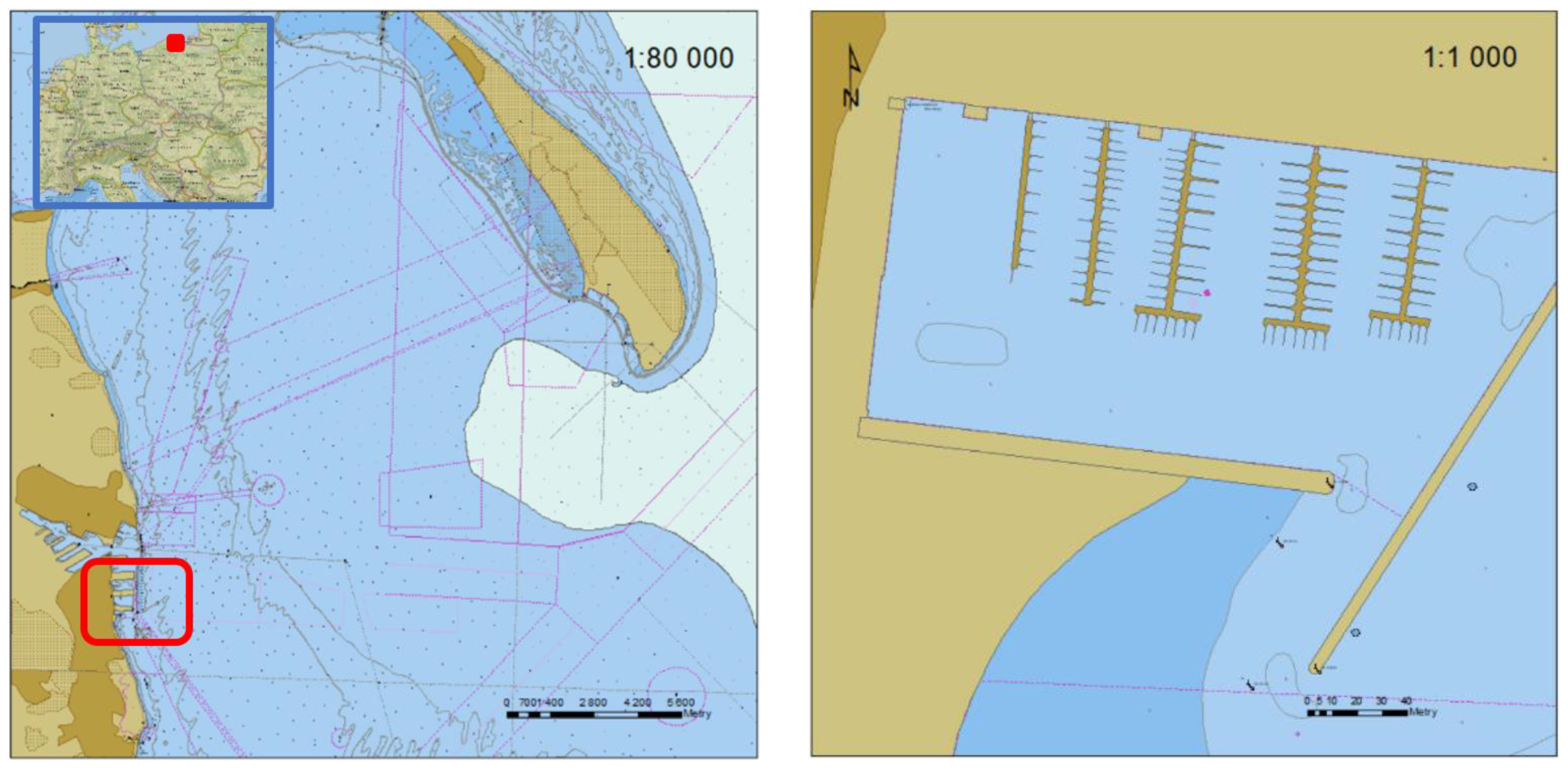
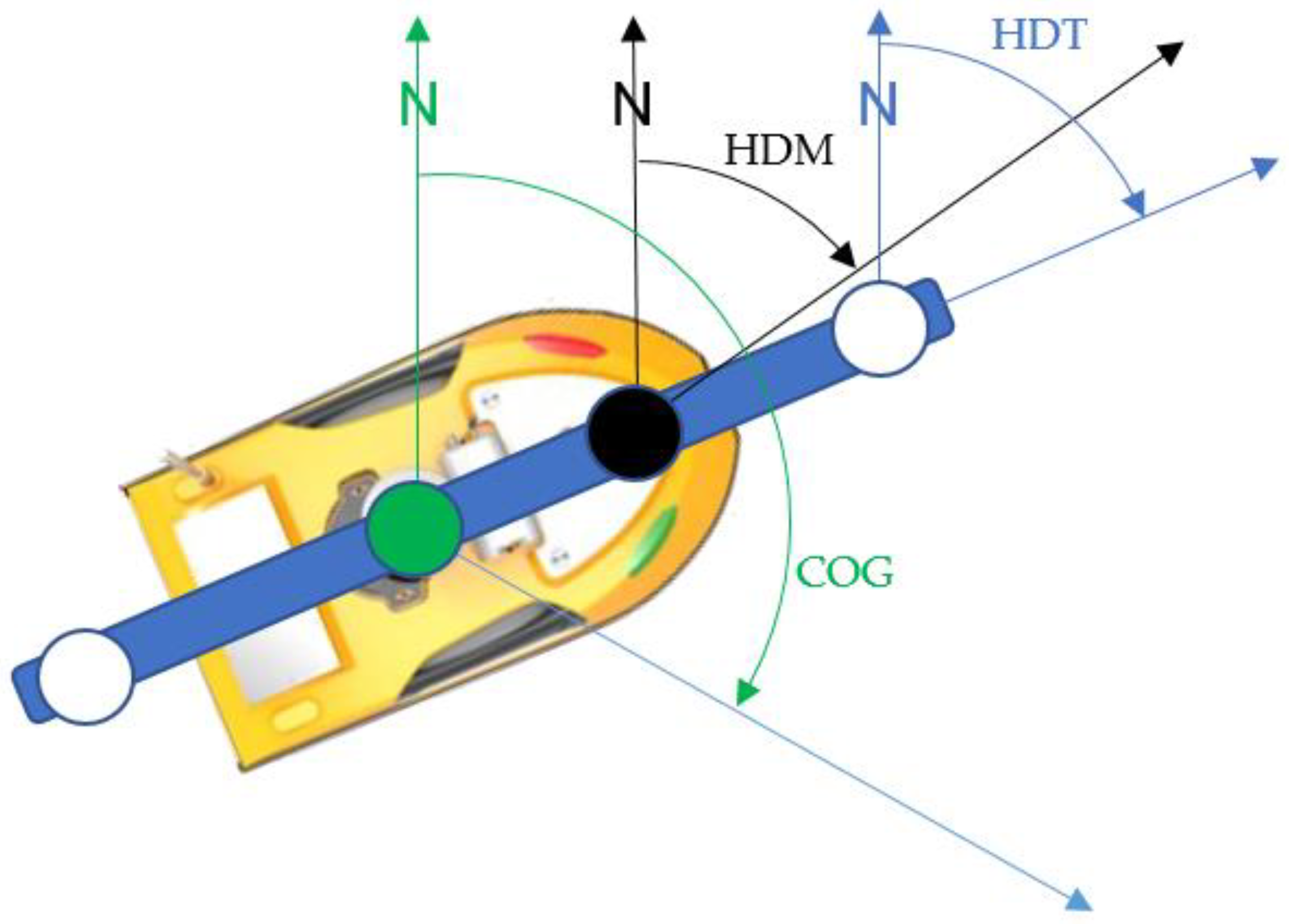

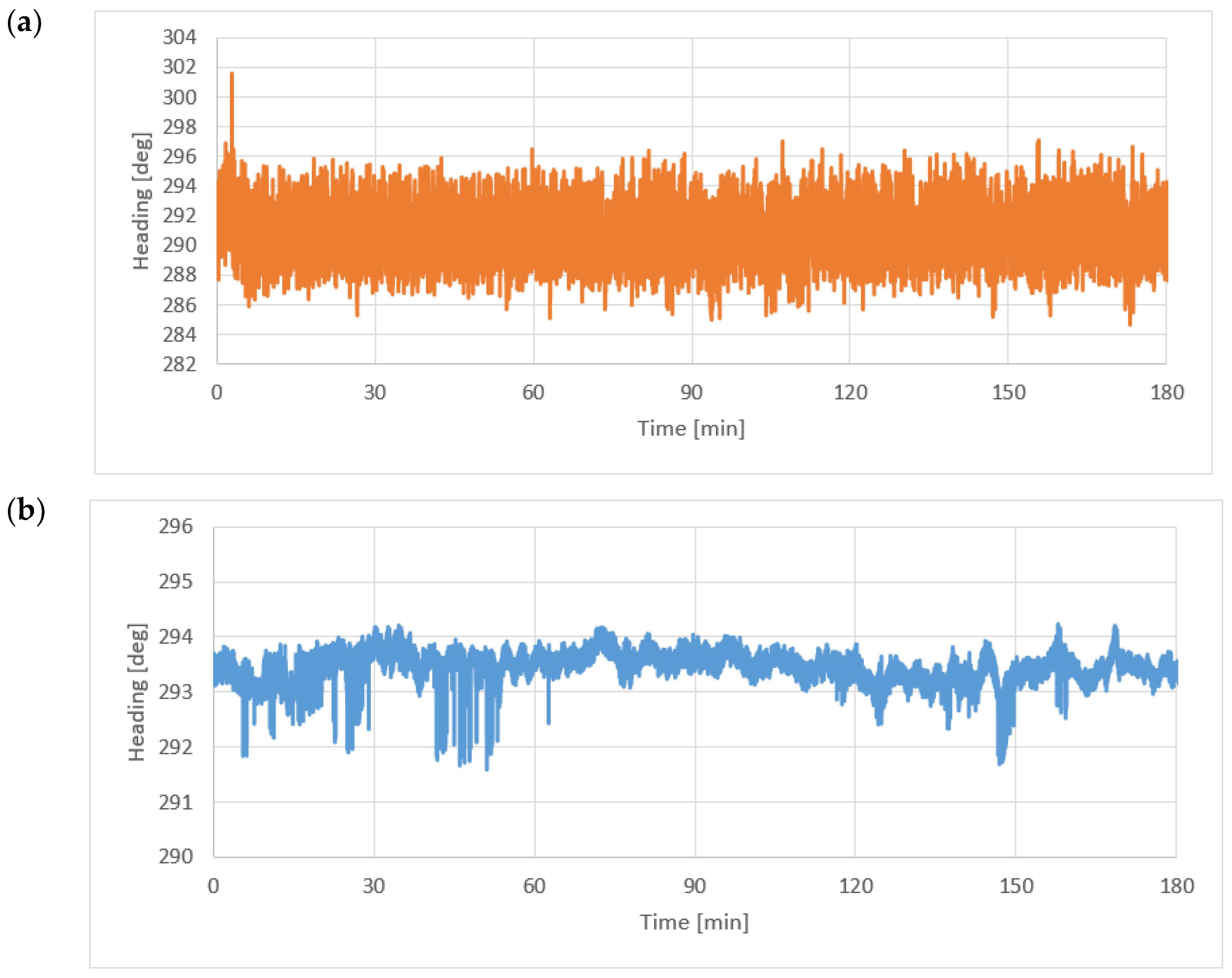
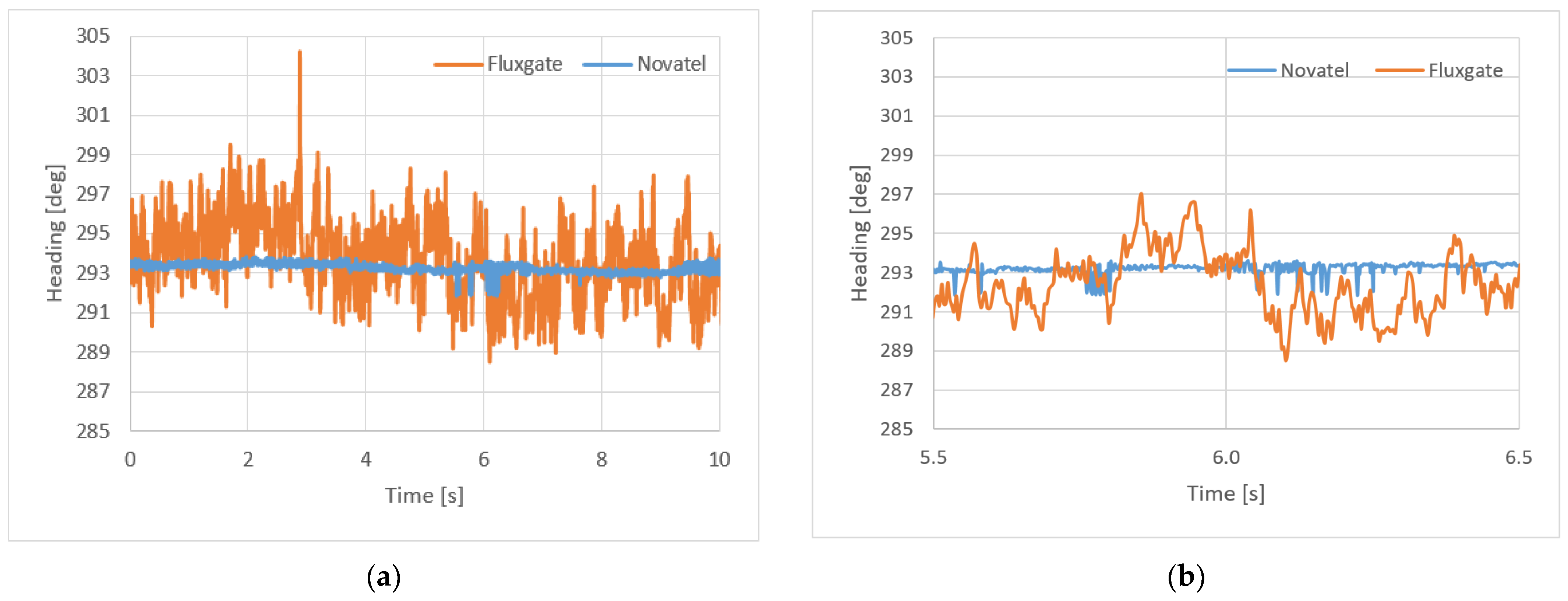


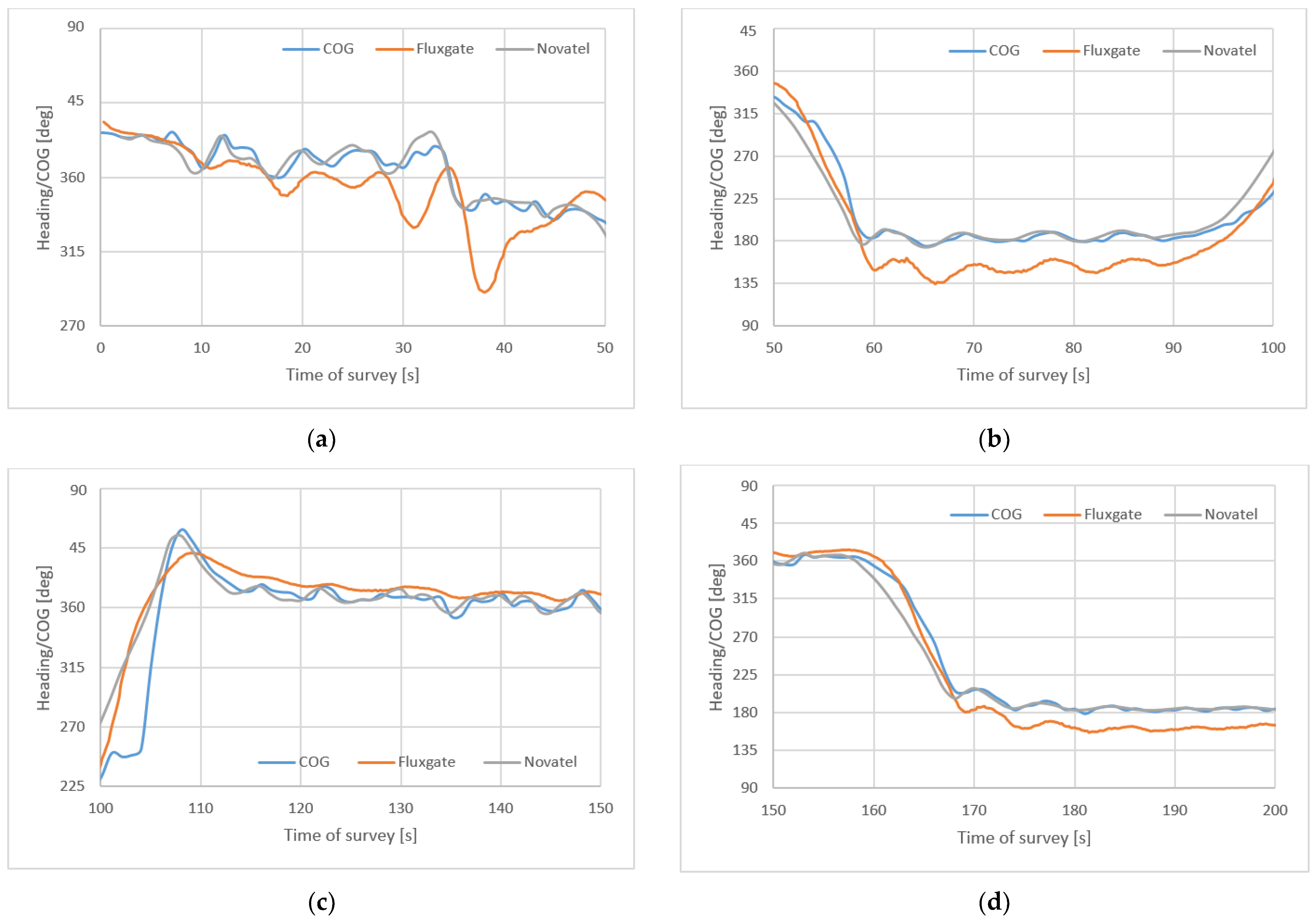
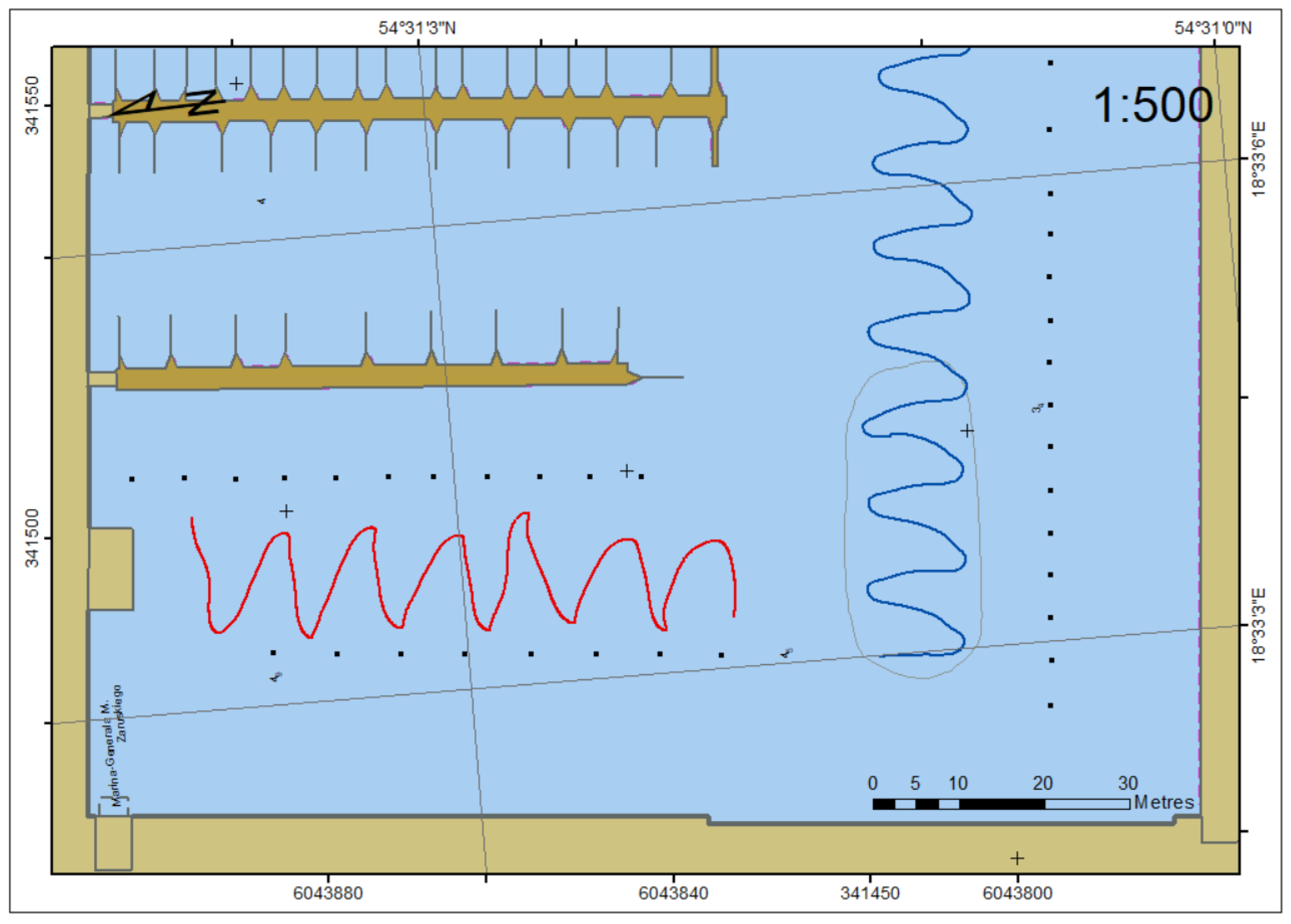
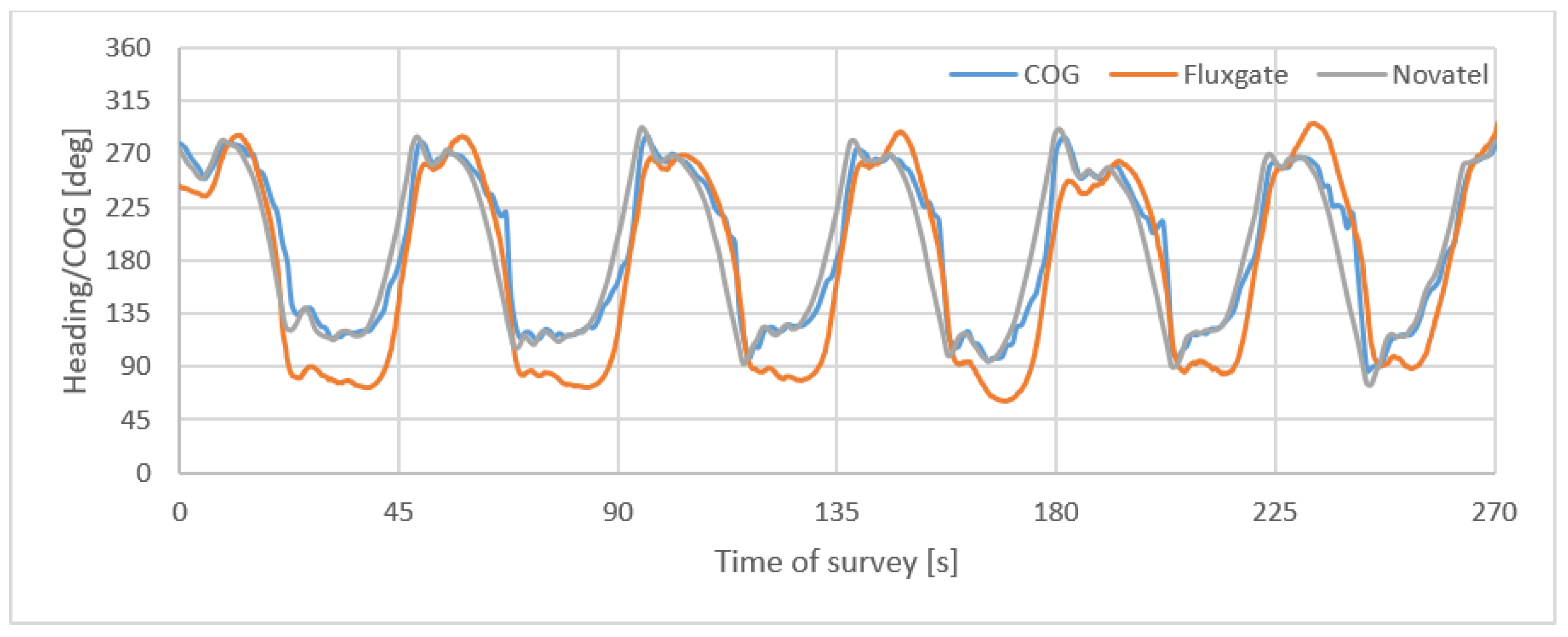
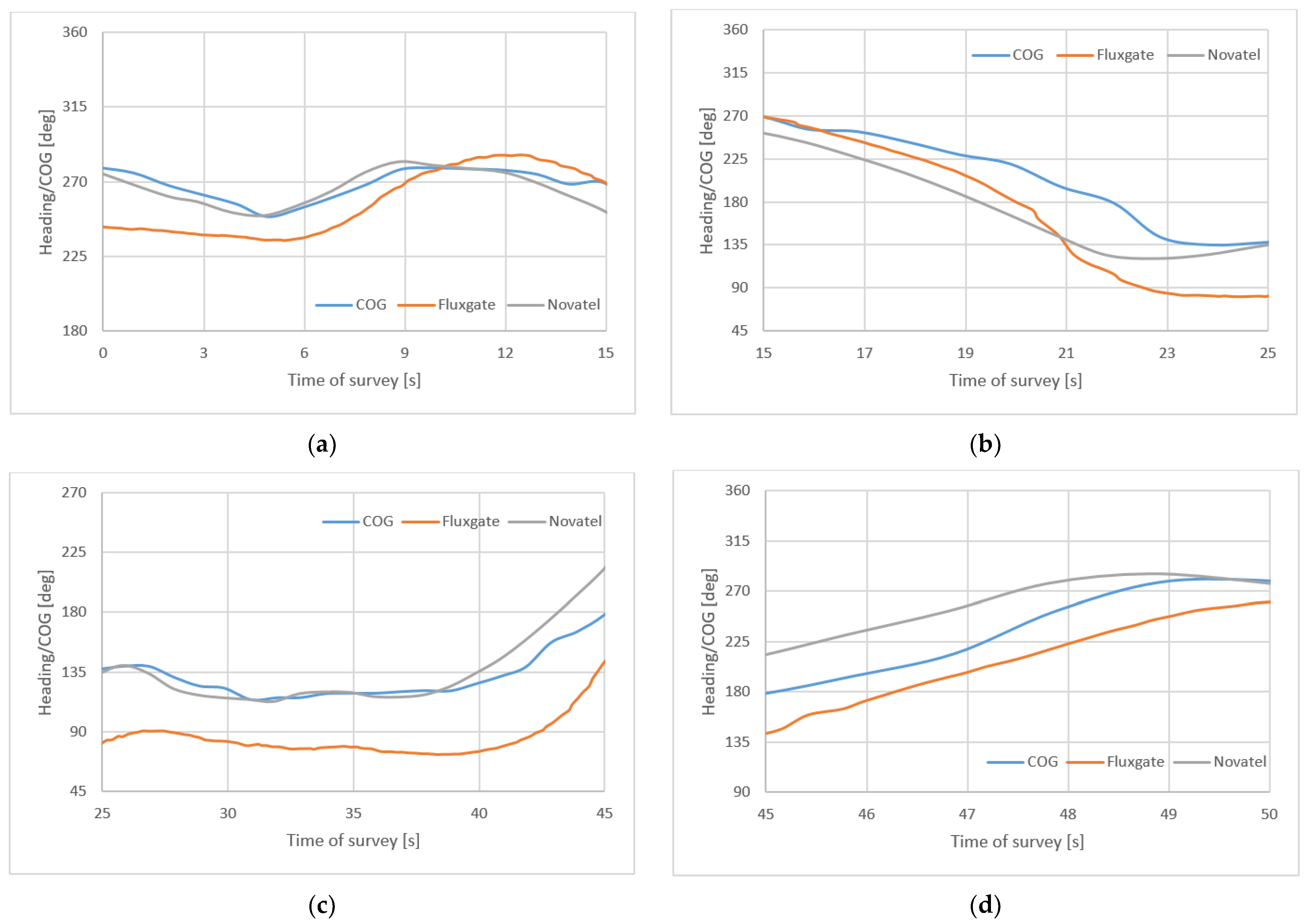

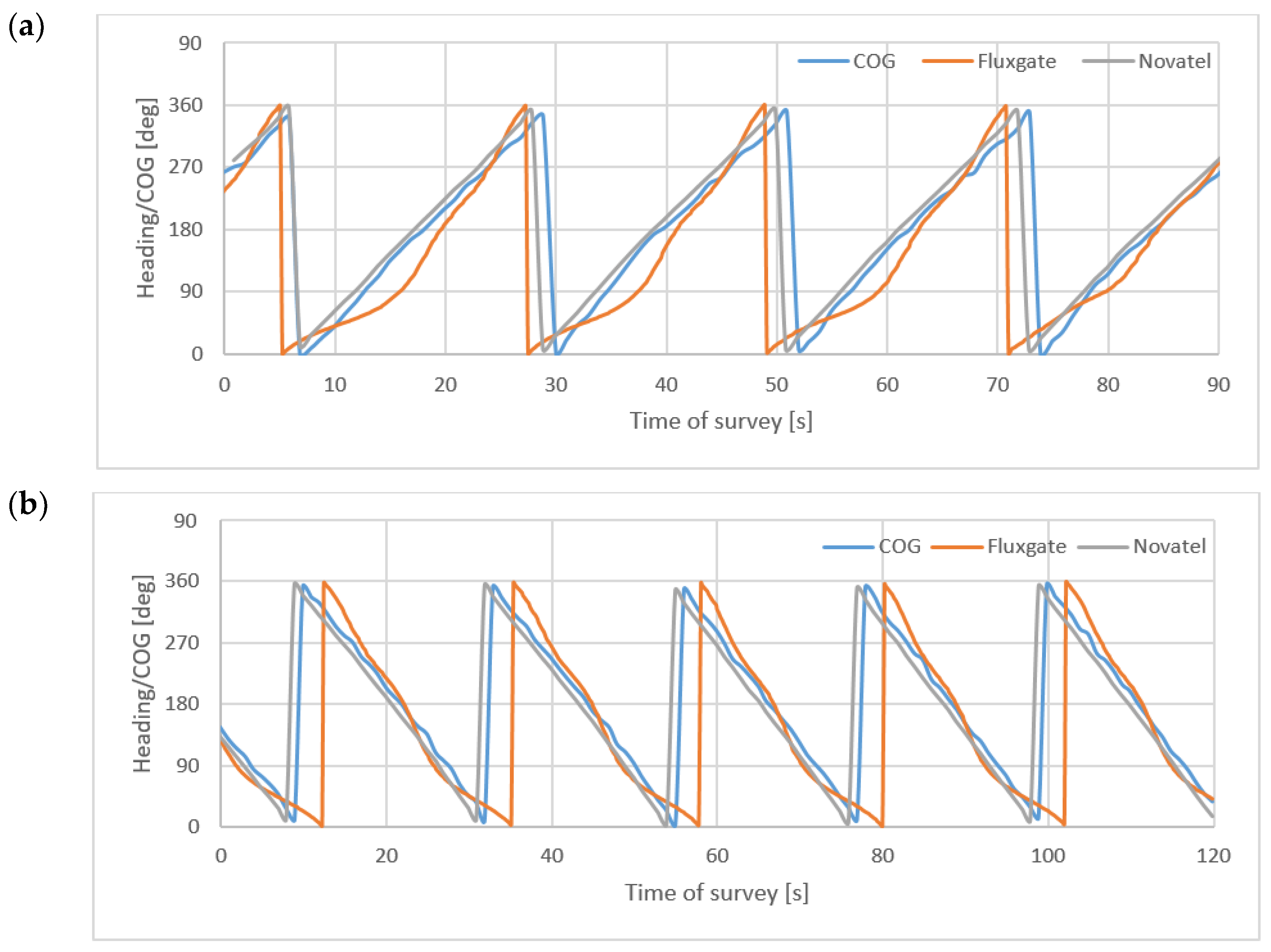
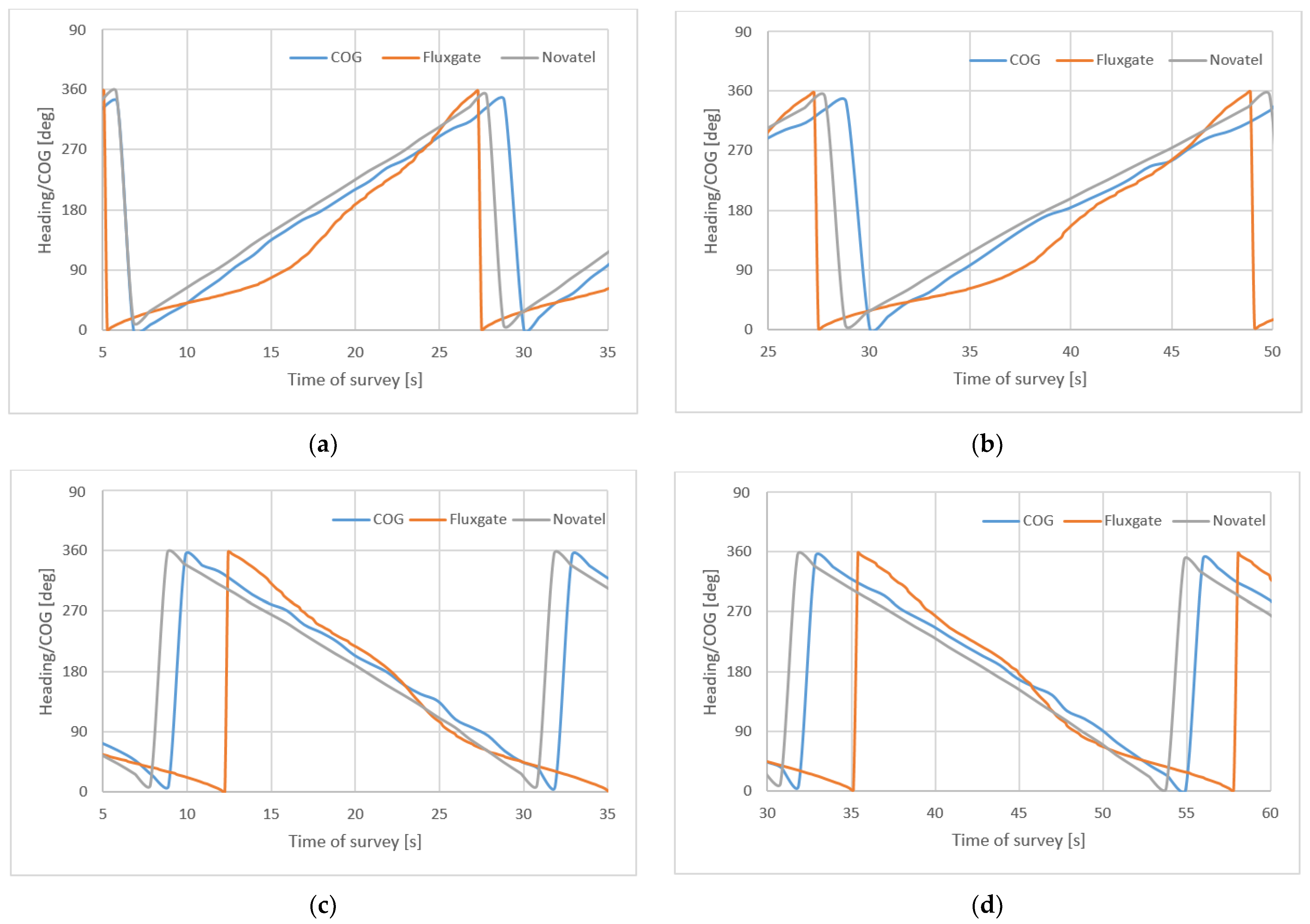
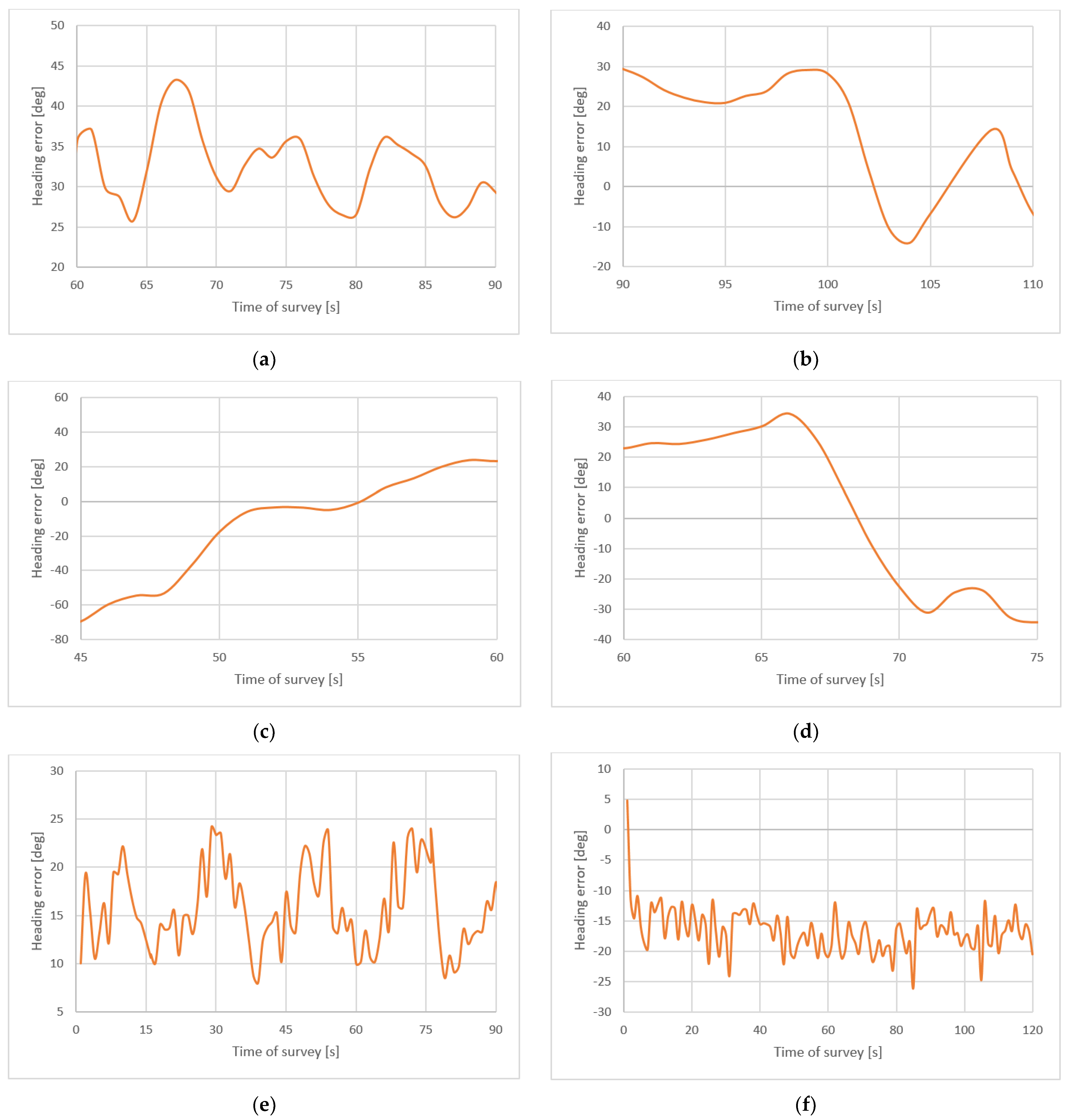

| Device | Photograph | Parameter | Value | |
|---|---|---|---|---|
| SL20 | 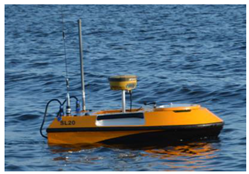 | Hull material | Carbon fiber | |
| Dimension | 105 cm × 55 cm × 35 cm | |||
| Weight | 17 kg | |||
| Draft | 15 cm | |||
| Propulsion | Water-jet propulsion | |||
| Survey speed | 2–5 kn (1–2.5 m/s) | |||
| Max speed | 10 kn (5 m/s) | |||
| Positioning (standard—not used) | U-blox LEA-6 series | |||
| Positioning (used in maneuvering) | Leica Viva GS15 | |||
| Heading | Honeywell HMC6343 | |||
| Echosounder | Echologger series SBES | |||
| Novatel PwrPak 7 |  | Signals Tracked Primary Antenna | GPS (L1 C/A, L1C, L2C, L2P, L5) GLONASS (L1 C/A, L2 C/A, L2P, L3) BeiDou (B1I, B1C, B2I, B2a, B2b) Galileo (E1, E5 AltBOC, E5a, E5b) NavIC (IRNSS) (L5) QZSS (L1 C/A, L1C, L1S, L2C, L5) SBAS (L1, L5) L-Band (Up to 5 channels) | |
| Code measurement precision | GPS GLONASS BeiDou Galileo | 4–8 cm 8 cm 4 cm 3 cm | ||
| Velocity accuracy | <0.03 m/s RMS | |||
| ALIGN heading accuracy | Baseline = 2 m 0.08 degrees Baseline = 4 m 0.05 degrees | |||
| Fluxgate INI-200 ATC |  | Accuracy | 0.2° | |
| Maximum operating magnetic inclination | 85° | |||
| Gimbal operating range Heel (roll) angle Pitch angle | ±45° ±45° | |||
| GNSS Leica Viva GS15 |  | GNSS technology | Advanced four constellation tracking | |
| Number of channels | 120 (up to 60 satellites simultaneously on two frequencies)/500 + 1 | |||
| Signal tracking | GPS (L1, L2, L2C, L5), Glonass (L1, L2), BeiDou (B1, B2), Galileo (E1, E5a, E5b, Alt-BOC) QZSS (L1, L2, L5), SBAS (WAAS, EGNOS, MSAS, CAGAN) | |||
| Code differential DGPS/RTCM | Typically 25 cm | |||
| Real-time kinematic Single baseline (<30 km) Network RTK | Hz 8 mm + 1 ppm/V 15 mm + 1 ppm Hz 8 mm + 0.5 ppm/V 15 mm + 0.5 ppm | |||
| Post-processing Static (phase) with long observations Static and rapid static (phase) | Hz 3 mm + 0.1 ppm/V 3.5 mm + 0.4 ppm Hz 3 mm + 0.5 ppm/V 5 mm + 0.5 ppm | |||
| Device | Message | Parameter | Frequency [Hz] |
|---|---|---|---|
| GNSS | $GPGGA, $GPGLL $GPVTG $GPGSA, $GPGSV | Position coordinates COG, SOG | 10 |
| Satellite compass | $GPHDT | Heading | 10 |
| Fluxgate compass | $HCHDM | Heading | 1 |
Publisher’s Note: MDPI stays neutral with regard to jurisdictional claims in published maps and institutional affiliations. |
© 2022 by the author. Licensee MDPI, Basel, Switzerland. This article is an open access article distributed under the terms and conditions of the Creative Commons Attribution (CC BY) license (https://creativecommons.org/licenses/by/4.0/).
Share and Cite
Makar, A. Determination of USV’s Direction Using Satellite and Fluxgate Compasses and GNSS-RTK. Sensors 2022, 22, 7895. https://doi.org/10.3390/s22207895
Makar A. Determination of USV’s Direction Using Satellite and Fluxgate Compasses and GNSS-RTK. Sensors. 2022; 22(20):7895. https://doi.org/10.3390/s22207895
Chicago/Turabian StyleMakar, Artur. 2022. "Determination of USV’s Direction Using Satellite and Fluxgate Compasses and GNSS-RTK" Sensors 22, no. 20: 7895. https://doi.org/10.3390/s22207895
APA StyleMakar, A. (2022). Determination of USV’s Direction Using Satellite and Fluxgate Compasses and GNSS-RTK. Sensors, 22(20), 7895. https://doi.org/10.3390/s22207895






